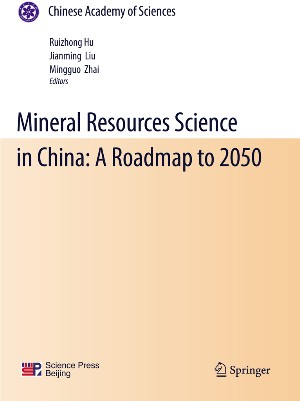Mineral Resources Science in China: A Roadmap to 2050
| 来源:【字号:大 中 小】
Mineral Resources Science in China: A Roadmap to 2050

Mineral resources represent the key material basis for the socio-economic development. Exploitation and utilization of mineral resources are the essential requirement for modernization. There are two basic and real contradictions in the field of mineral resources in China. One contradiction is between the great demand for mineral resources and the shortage of the proved reserves of major minerals. The other is among the huge potential of mineral prospecting, insufficient utilization of mineral resources, the prominent environmental challenges by mineral exploitation, and the relative low level of research, exploration and exploitation on deposits. At present, the key issue is how to tap the huge potential of mineral resources, and to improve their utilization efficiency, consequently, to relieve the situation of severe shortage of proved reserves of major mineral resources in China, furthermore, to secure the coordinated development between exploitation and utilization of mineral resources and the construction of ecological environment. In our view, in order to resolve the above problems, many corresponding measures, such as, the rational utilization of international resources, reduction of minerals consumption for unit output and improvement of mining management should be regarded. In addition, on the basis of the systematic cognition on the unique evolution history of the lithosphere beneath China, we should focus on three scientific questions related to the research on metallogenic theories and rules, i.e., the accumulation process of huge volumes of ore-forming materials, the spatial and temporal distribution regularities of deposits and the relationship between metallogenic model and prospecting model. Moreover, we should make breakthroughs in three important technical directions including the prospecting of concealed mineral resources in covered areas and in depth, the clean and efficient utilization of mineral resources, the substitute and recycling utilization of mineral resources. In addition, the integration, test, demonstration and application of relevant technologies should be improved.
The short, middle and long terms strategic blueprints are given below. From present to 2020, our objective is firstly to determine the metallogenic rules and prospecting prospects in major metallogenic regions and belts, to make breakthroughs in accurate element determination technology on site, aerogeophysical technology, high-precision technology for extracting metallogenic information, and the high-resolution geophysical technology prospecting mineral resources in depth (up to 2,000m in depth) in eastern China. Secondly, our objective is to improve the recovery rates of mineral resources in processes of mining, processing and smelting in major mines, as well as the rates of comprehensive utilization of the symbiotic and associated deposits. Thirdly, our objective is to undertake the pilot research and development on the technology for substituting some kinds of mineral resources with shortage reserves. Fourthly, our objective is to make breakthroughs in technology for efficient recycling of used metals. Fifthly, it is to improve the ecological environments of mines in China. From 2020 to 2030, we should be able to establish the continental metallogenic theoretical system of China; to make breakthroughs in technologies for efficient and high-precision exploring mineral resources within 2,000m in depth in western China, for clean and efficient utilizing low-grade ores and tailings, and for making fertilizer with non-water-soluble potassium resources, to basically restore the ecological environment of historical abandoned mines, and eventually to control the environmental pollutions. From 2030 to 2050, we should be able to unravel the relationship between the Earth system and metallogenic system, to make breakthroughs on the technology for exploring mineral resources within 3,000–4,000m in depth, to develop a series of core technologies for clean and efficient utilization of mineral resources, to make breakthroughs in technology for substituting common metal materials by silicate fiber, and finally, to build a system for the sustainable supply and utilization of mineral resource in China, and to secure the coordinated development between the exploitation and utilization of mineral resources and construction of ecological environment.
The main indexes set for various periods are given below. Until 2020, the rate of proved reserves of major mineral resources in deep earth (up to 2,000m in depth) in eastern and central China should reach 50%. The total recovery of mineral resources should reach 50%. The rate of comprehensive utilization rate of mineral resources should be 45%. The energy consumption should be reduced by 20%. The discharges of waste gas, waste water and industrial residue (“three wastes”) should drop down by 30%. The ecological environment of 45% historical abandoned mines in China should be rehabilitated, and the environment of 30% polluted mining area should be restored. Land reclamation rate in new mines should reach 100%. The rate of alternative and cyclic utilization of the crucial mineral resources should reach 20%–40%. From 2020 to 2030, the rate of proved reserves of mineral resources within 2,000m in depth in western China should meet 50%. The total recovery of mineral resources should attain 70%. The rate of comprehensive utilization of mineral resources should reach 60%. The energy consumption should be reduced by 30%. The discharges of “three wastes” should drop down by 50%. The ecological environment of 65% historical abandoned mines should be rehabilitated, and the environment of 50% polluted mining areas should be restored. The rate of alternative and recycling of the crucial mineral resources should achieve 30–50%. From 2030 to 2050, the rate of proved reserves of mineral resources in depth between 3,000m and 4,000m in China should meet 70%. The total recovery of mineral resources should reach 80%. The rate of comprehensive utilization of mineral resources should be 80%. The rate of energy consumption per unit should be reduced by 50%. The rate of discharges of “three wastes” should drop down by 80%. The ecological environmental damage and pollutions caused by mining, processing, smelting and other processes mining industry should be properly controlled. The rate of alternative and cyclic utilization of the crucial mineral resources should achieve to 40%–60%.
